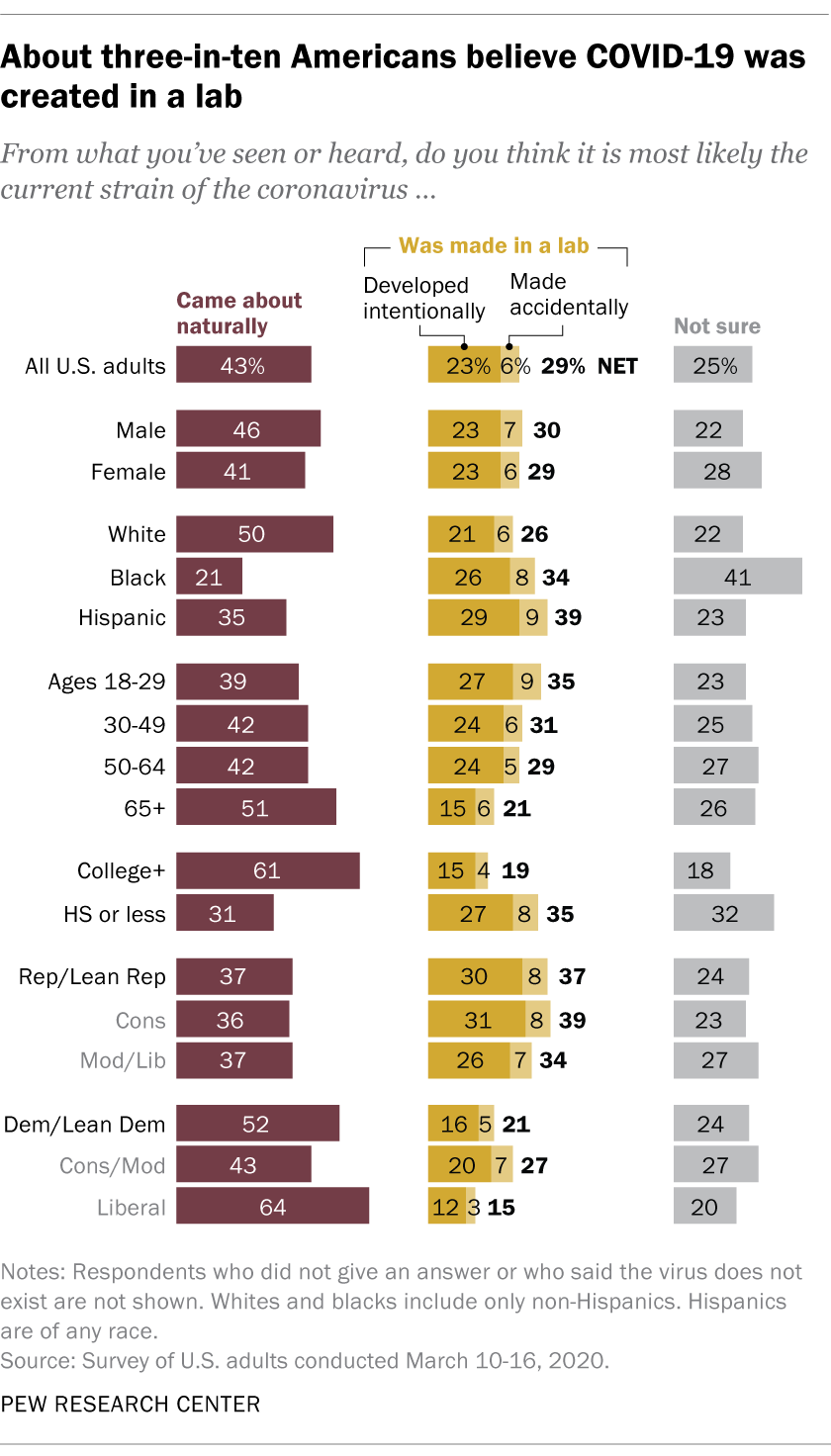 As news and misinformation about the COVID-19 pandemic has spread, many Americans have encountered conflicting narratives about how the new coronavirus originated. Scientists have determined the virus came about naturally, but there is some uncertainty about how it first infected people.
As news and misinformation about the COVID-19 pandemic has spread, many Americans have encountered conflicting narratives about how the new coronavirus originated. Scientists have determined the virus came about naturally, but there is some uncertainty about how it first infected people.
While a plurality of Americans (43%) say the new coronavirus most likely came about naturally, nearly three-in-ten (29%) say it most likely was created in a lab, according to a Pew Research Center survey conducted from March 10 to 16, 2020, as part of the Center’s nearly yearlong Election News Pathways project.
Around a quarter of adults (23%) say it is most likely that the current strain of coronavirus was developed intentionally in a lab; another 6% say it was most likely made accidentally in a lab. A quarter say they aren’t sure where the virus originated.
To explore the extent to which misinformation has made its way into the news people get about the COVID-19 outbreak, we focused on the belief of some Americans that the virus was created in a lab. We used data from a survey of 8,914 U.S. adults conducted March 10 to 16, 2020, as part of the Center’s nearly yearlong Election News Pathways project.
All survey participants are members of the Center’s American Trends Panel, a nationally representative online survey panel. Panelists were recruited by telephone or mail so that nearly every U.S. adult has a known chance of being selected. The data is weighted to further ensure it reflects the U.S. adult population by gender, race, ethnicity, partisan affiliation, education and other categories.
Here are the questions asked for this report, along with responses, and its methodology. Visit our interactive data tool to access the data on the coronavirus pandemic and other issues related to news and the election.
Americans differ by age, education level and race and ethnicity when it comes to who believes that the virus was created in a lab:
- Younger adults are more likely than older people to say the virus was developed in a lab. For example, about a third of adults ages 18 to 29 say the virus was developed in a lab (35%), compared with 21% of adults 65 and older. Nearly four-in-ten (39%) adults under 30 say it came about naturally, while 51% of those 65 and older say this.
- Educational attainment is also a factor. Those with a bachelor’s degree or more education are less likely than those with a high school diploma or less education to say the coronavirus was created in a lab (19% vs. 35%). A majority (61%) of those with at least a bachelor’s degree say the virus came about naturally, compared with 31% of those with a high school diploma or less.
- The belief that the coronavirus was created in a lab also is more prevalent among Hispanic and black Americans than among whites. About four-in-ten Hispanic adults (39%) say the virus was created in a lab. Among black adults, 34% say the same. Around a quarter of white adults (26%) say it was developed in a lab.
- When it comes to political affiliation and ideology, Republicans and Republican-leaning independents are more likely than Democrats and Democratic leaners to say the coronavirus was created in a lab (37% vs. 21%). About four-in-ten conservative Republicans say this (39%), the largest share of any ideological group.
Confusion surrounding these facts parallels Americans’ overall experience with misinformation during the outbreak. About half of U.S. adults (48%) report having come across at least some news and information about COVID-19 that seemed completely made up, with 12% saying they have seen a lot of it and 35% saying they have seen some.
Note: Here are the questions asked for this report, along with responses, and its methodology.



